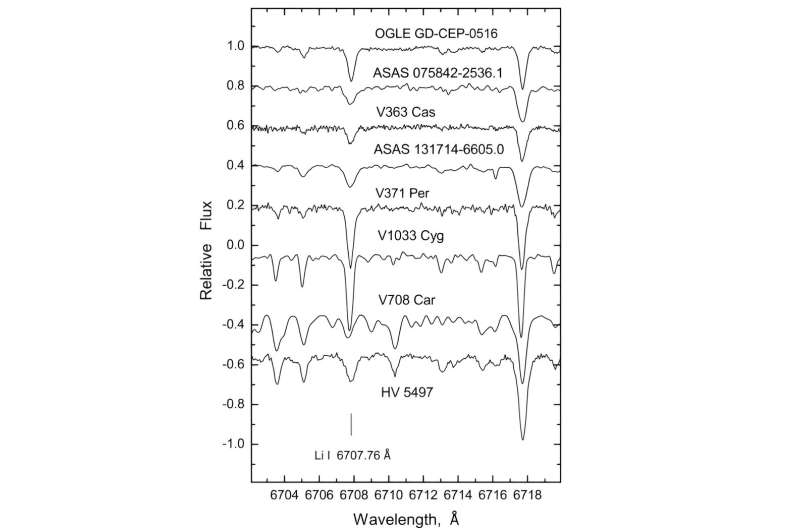February 27, 2024 report
This article has been reviewed according to Science X's editorial process and policies. Editors have highlighted the following attributes while ensuring the content's credibility:
fact-checked
preprint
trusted source
proofread
Variable star V708 Car has an unusual chemical composition, study finds

An international team of astronomers has performed spectroscopic observations of a variable star known as V708 Car. Results of the observational campaign, reported in a paper published February 20 on the pre-print server arXiv, indicate that this star has an unusual chemical composition.
Cepheid variables (or Cepheids) are luminous, yellow, horizontal branch stars changing their brightness with time as a result of regular stellar pulsations. Given that their periods of variation are closely related to their luminosity, astronomers use them to measure interstellar and intergalactic distances.
Classical Cepheids, also known as Population I Cepheids, undergo pulsations with very regular periods on the order of days to months. Given that their pulsation and stellar parameters are strictly connected, these variables are also used as a testbed for stellar evolution theories.
Located about 14,350 light years away from the Earth, V708 Car is a massive long-period classical Cepheid. Previous observations have found that it is a supergiant star with a mass of some 12 solar masses, pulsation period of approximately 52.4 days (which increases at a rate of 52 seconds per year), and its luminosity is at a level of 18,400 solar luminosities.
However, although V708 Car has been known for two decades, it remains a poorly studied variable. That is why a group of astronomers led by Valery V. Kovtyukh of the Odessa National University in Ukraine, decided to conduct a spectroscopy of this star using the High Resolution Fiber échelle Spectrograph (HRS) at the Southern African Large Telescope (SALT).
All in all, HRS allowed the team to derive abundances of 27 chemical elements for V708 Car. The results show that this star is lithium rich, which is generally rare among supergiant Cepheids, as to date only six such objects have been identified. The effective temperature of V708 Car was measured to be 5,206 K, while its metallicity was estimated to be at a level of -0.4 dex.
By analyzing the collected data, it was found that V708 Car has an anomalous chemical composition. It turned out that the measured abundances of the chemical elements show a clear correlation with their condensation temperature—the higher the condensation temperature, the lower the abundance. The authors of the study suppose that such an anomaly may be a result of dust–gas separation in the envelope (or extended atmosphere) of the star.
"Through this mechanism, refractory elements form dust grains in the envelope that are swept out of the envelope by the radiative pressure of the star. The gaseous fraction, enriched in volatile elements, is accreted by the star, and eventually, its atmosphere acquires the observed peculiarity," the researchers explained.
The astronomers added that the observations probably caught V708 Car at a very short-term evolutionary stage of interaction with the shell.
More information: V. V. Kovtyukh et al, Lithium Cepheid V708 Car with an unusual chemical composition, arXiv (2024). DOI: 10.48550/arxiv.2402.13072
Journal information: arXiv
© 2024 Science X Network



















